( A Landlocked Atlantic salmon in a river mouth estuary doing a shark attack on my Raccoon Sculpin Intruder- image @MattSupinski )
My fingers and hands were going numb and turning into icicles. It was yet another failed purchase of the latest hi-tech fingerless gloves bought compulsively in search of warmth and their false marketing promises. But maybe my hands have been forebitten so any times Renaud’s would not even categorize them as to their severity from all the decades steelhead guiding and not wearing gloves from the euphoric false sense of warmth- one created by the endless casting and hunt for the often elusive mykiss. The abuse you take for being a foul weather chrome chaser makes no sense to most fair weather anglers who say “why undergo all that punishment for a fish”. As you get older the arthritis burn bestowed upon you from a lifetime of living and fishing in the frozen Arctic -like dreariness of sunless and depressing Great Lakes winters gets chronic- yet you continue to punish yourself and tolerate it with anti-inflammatory pill popping and whiskey in a coffee thermos in search of the tug. As the wind burn on the face continued to sting as the sleet slapped and battered it I cursed the weather Nazi’s who got it wrong again- the predicted 5 mph winds turned into 40 gales. Despite it I launched yet another in the countless “fish of a thousand casts” cadence in search of the pre-spawn migratory leaper in a broad, graveled, river outlet with current reminiscent to Tierra del Fuego estuaries- a place itself that is no stranger to blistering gales. It was a serious northeasterly blow hard off the big lake where I was targeting the fall trifecta of pre-spawn landlocked Atlantics, lake-run browns and steelhead- three fish I am addicted to.
I persisted in swinging my Raccoon Sculpin– my interpretation and inspiration for the perfect goby/ perch/ hexagenia/ stickleback/sculpin et al imitation with lots of movement. The snow stung my face as I just got done with a sloppy swing from the wind spanking my spey rod around about like a lighthouse flag pole. I was just about to lift it from the water from the swing/strip and prepare for another cast as a shark-like attack from a grayish blue-backed Atlantic targeted the intruder at a high speed near the surface- something Atlantics love to do with their Formula 1 speeds. What was really cool was that the the kyped jawed beast continued to hover and circle the area looking for what it missed in an intense focus. I quickly cast the intruder back and within a second the Atlantic pounced on it like a cheetah. Four awesome leaps and a blistering run into my backing and the gorgeous kyped male was beached. The savage attack was something we cast for fishless hours and often days to achieve. As I beached it on the fine gravel of the banks, I took an image and gave it a kiss to let him go onto his journey up river. The feeling you get from that experience is pure ecstasy that washes away all the agony you’ve endured. Its the dope that keeps you coming back forever.
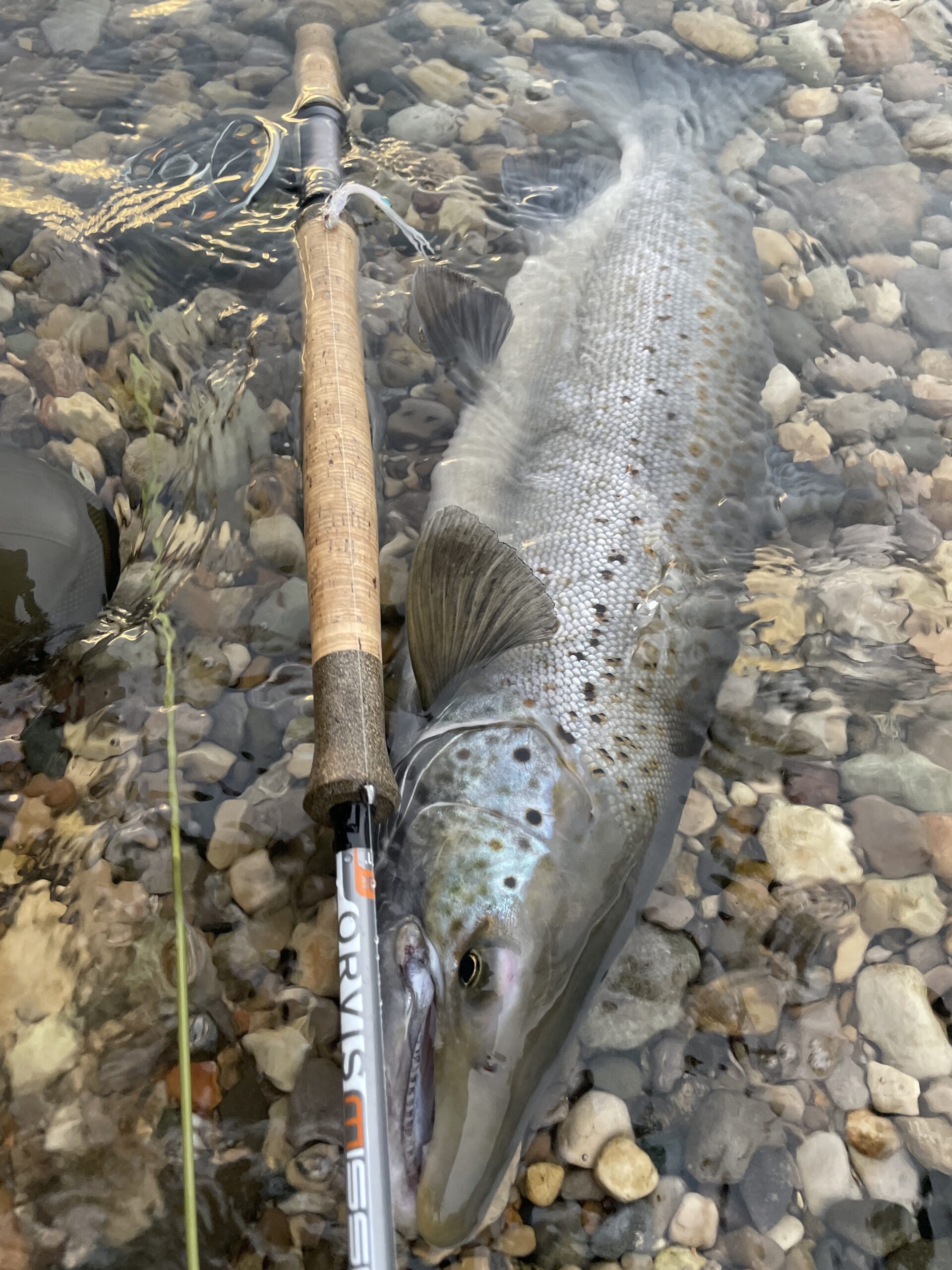
My topic perhaps seems unimportant to many anglers. All that natters to most is that the fish occasionally do strike the swung or drifted fly and they catch one. But to many of those cursed and torn with the “how’s and why’s” pertaining to our cerebral subject and finicky fish, it is like a sweet tonic and elixir that brings back many past fond encounters and angling episodes. Yet in retrospect, this topic is an endless preoccupation and obsession that has been pursued by all the fanatical legends and inquisitors of the swung fly to entice a chromed migratory salmonid into striking their escaping or drifting offering. Contemporaries like Wulff and Lee, Browne, Bates, and Nightingale, and countless Anglophiles dating back to the grand lady Juliana herself, along with Falkus and an ardent school of Scottish spey founders and gillies like Jock Scott in the 18th and 19th century, all tangled with this cryptic dilemma of Atlantic salmon, and why they strike a fly. In the steelhead brain drain, Waller, Combs, McMillan, Hogan and I too have fallen into that endless abyss and entrapment of these perplexing questions of how and why these migratory fish strike the fly. In my theoretical books from “Selectivity” describing the fish’s states of arousal, discrimination or dormancy; to my “The Brown Trout-Atlantic Salmon Nexus” book, and the Salmo salar’s close bond with the lovely and finicky bachforellen brown trout, the questions of how to capture them inspired Neanderthals and composers’ alike, like Schubert capturing their mood in his “Trout” quintet. It is a journey into a twisted angling mind that forever needs to be fed with an enigmatic closure.

In my Hallowed Waters Podcasts I call these fish the provocateurs’ of the ” cognito ergo sum “- “I think therefore I fly fish” for them. The beauty or some will say curse is that it never really has that end that justifies the ridiculous hours spent in the act and means of launching cast after cast in hopes of achieving the nirvana of the “drug in the tug” and hook-up. Some anglers may call it a fool’s errand. But to spey swingers it is the endless pursuit and buzz.
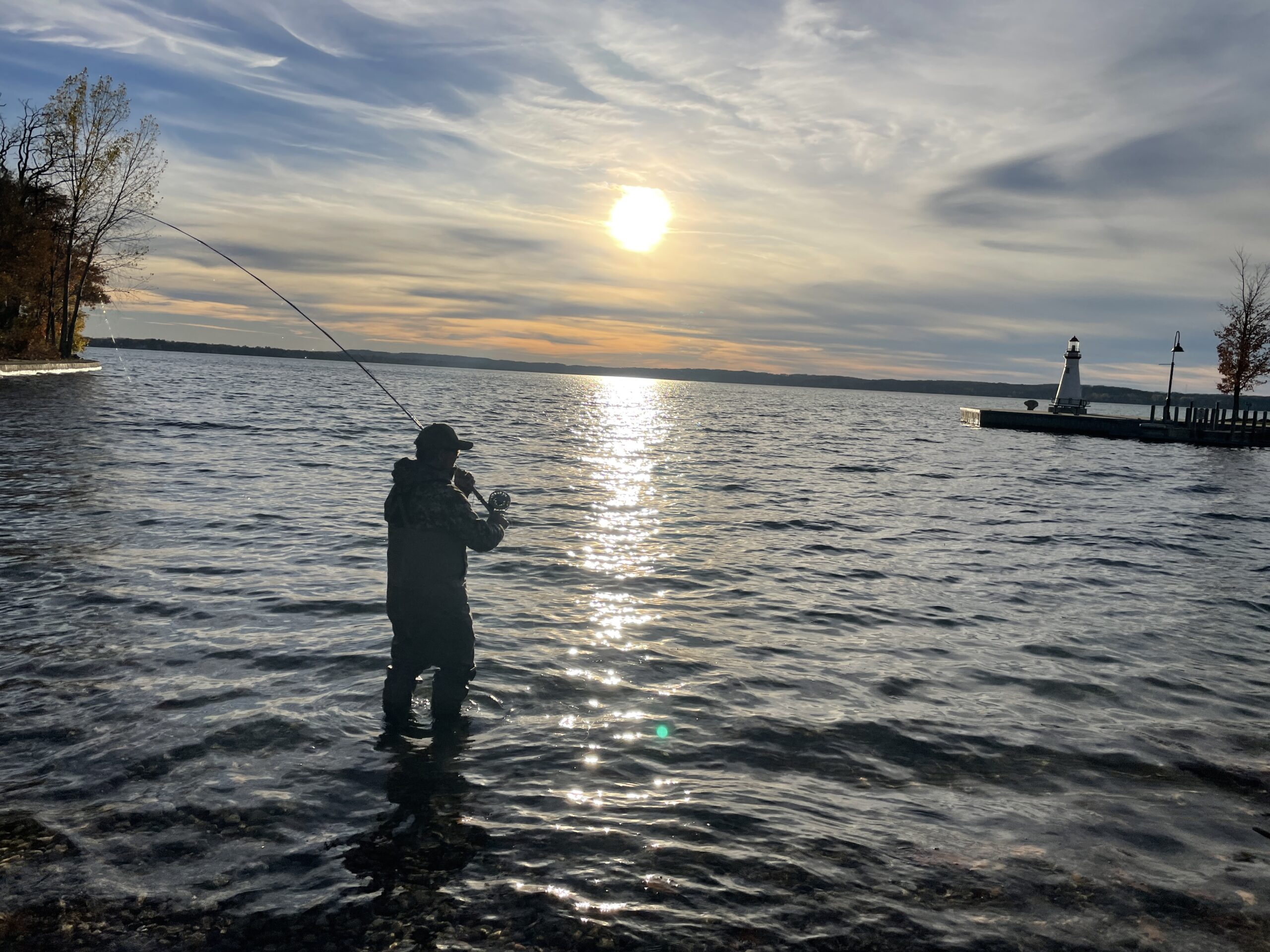
A migratory salmonid entering its natal rivers to spawn does not need to eat for all practical biological purposes. It can and sometimes forgoes food for up to a year. It is a migratory majestic beast that’s beauty is unparalleled and leaves us breathless and speechless once caught and lying in our hands, as we keep them wet and let them go. But it is in their savage attacks of our fly that interests us the most and why they do it. As we proceed I will attempt to give all the presumed reasons and observations we can deduce from how migratory salmonids take the spey swung as well as drifting fly.
THE BASIC INSTINCTUAL DRIVE
Atlantic salmon, steelhead and sea/lake run browns all have similar instinctual drives and behaviors- to run, spawn, leave and resume feeding in the big water. But each has peculiar behaviors, skills, quirks and abilities the other doesn’t possess. Many, as Lee Wulff continually ascertained that the natal stream development was the crux of their feeding behavior to take the fly , due to the riverine biological drift of insects, crustacea and baitfish stimulating that feeding drive, curiosity and the proverbial “going through the motions” of biting/poking at food behaviors driven from time as a feeding river resident parr.
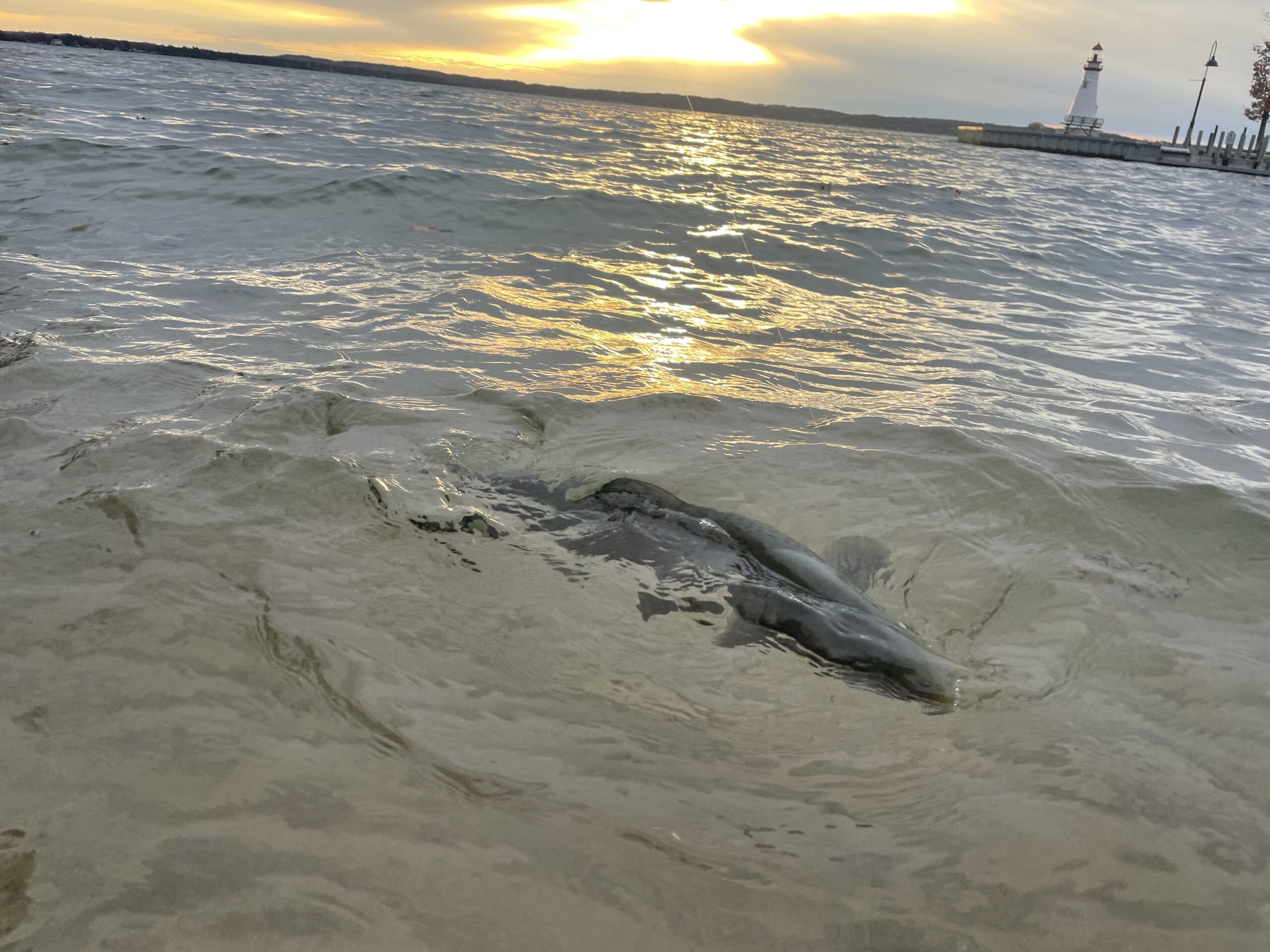
In my Selectivity book, with a bold and adventurous theory of mine, I compared the three stages of salar migration to Freudian psychoanalytic life phases. To refresh you if you haven’t read it, I described the first run phase of early spring/ June as the ID phase- the proverbial “bull-in-a-China shop” of hedonistic actions , where the fresh run Atlantic salmon ( holds true for steelhead and all migratory salmonids) , chromed silver and dripping scales from the sea with sea lice, would attack aggressively a swung Blue Charm, Magog Smelt, Lady Amherst or Green Highlander fly with a reckless abandon, and with cartwheeling leaps, thus providing the ultimate sport. Due to their sophisticated vision: rods and cones, they are adjusted for pelagic bait hunting and still focus on the green/ blue/purple spectrum that they acclimated to from the ocean to see their prey. Hence those color motifs in fly patterns are still very firmly ingrained into their prey/ predator attack modes.

Once fish settle into the incubator riverine pools from the big seas or lakes, they now must adjust to their new holding pattern river environments until spawning in fall for salmon and browns- or late winter/spring for steelhead, which then they are fully gravid with eggs and sperm. Survival of the fittest behaviors now favors dour attitudes to flies, since striking behaviors will have consequences like getting caught or elimination from the genetic pool. This is similar to human experiences in the EGO state of development, where behaviors are finally judged and internalized to have consequences. So, running around and chasing Green Highlanders; or Double Deceivers, intruders, or egg flies etc. , is not to be of paramount importance under the urge to survive and make it to procreation, which evolution has favored them for millions of years.
So here is the eternal question that continues to baffle anglers wherever they find the salmon, steelhead, sea trout nexus-why chase and attack a fly? Yes the aggressive tendency to take the fly exists even during this procreation period, but perhaps less than 50% of that migration is apt to take the fly and be the “alpha takers” that make the trophy column. It is also similar with large trophy Brown trout that just stubbornly refuse to take a fly fishers imitative offerings, no matter how perfectly presented and duplicated. Biologists know that many brown trout die from a secluded predatory lifestyle and die of old age having been never caught.
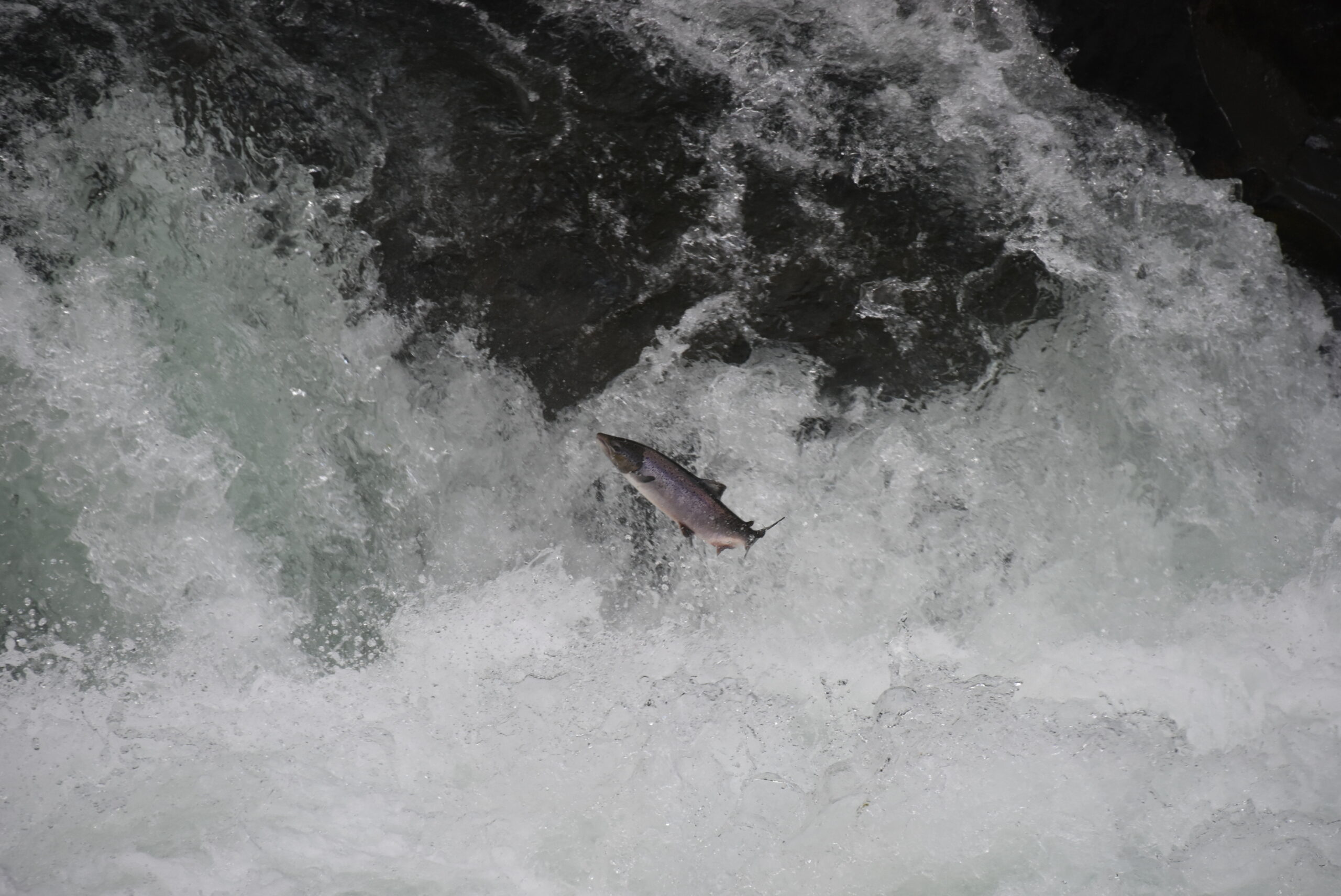
But is this disdain to take the fly a result of being shy and inferior aggressors? -or from being caught before and having learned avoidance techniques. Or is it having ultra-superior sensory perception of sensing vibrations, vision, and a sense of natural prey alerts etc.? Can this be incorporated into some learned response as part of its DNA inherited behavioral structure- such therein lies the migratory take/ refusal conundrum. Thus it is so important for us to practice catch- and- release on these alpha takers, since there aggressive tendency is firmly planted into their next generation to breed more aggressive fly takers and have attack sport.
Phases of the run dictate the attack triggers. In my Selectivity, the aggressive/selective/passive phases of migrating salmonids reveals everything about their willingness to take the fly. Fresh chromed fish that start out of the big water briny are usually in full predatory baitfish attack mode. Once acclimated to new surroundings and alpha holding niche lies the quick attack trigger that turns more into riverine trout-like selective/reflective curiosity with natal food forms. Once spawning has commenced it is pure aggression that can elicit a territorial strike since these fish are in a passive/dormant prey phase.
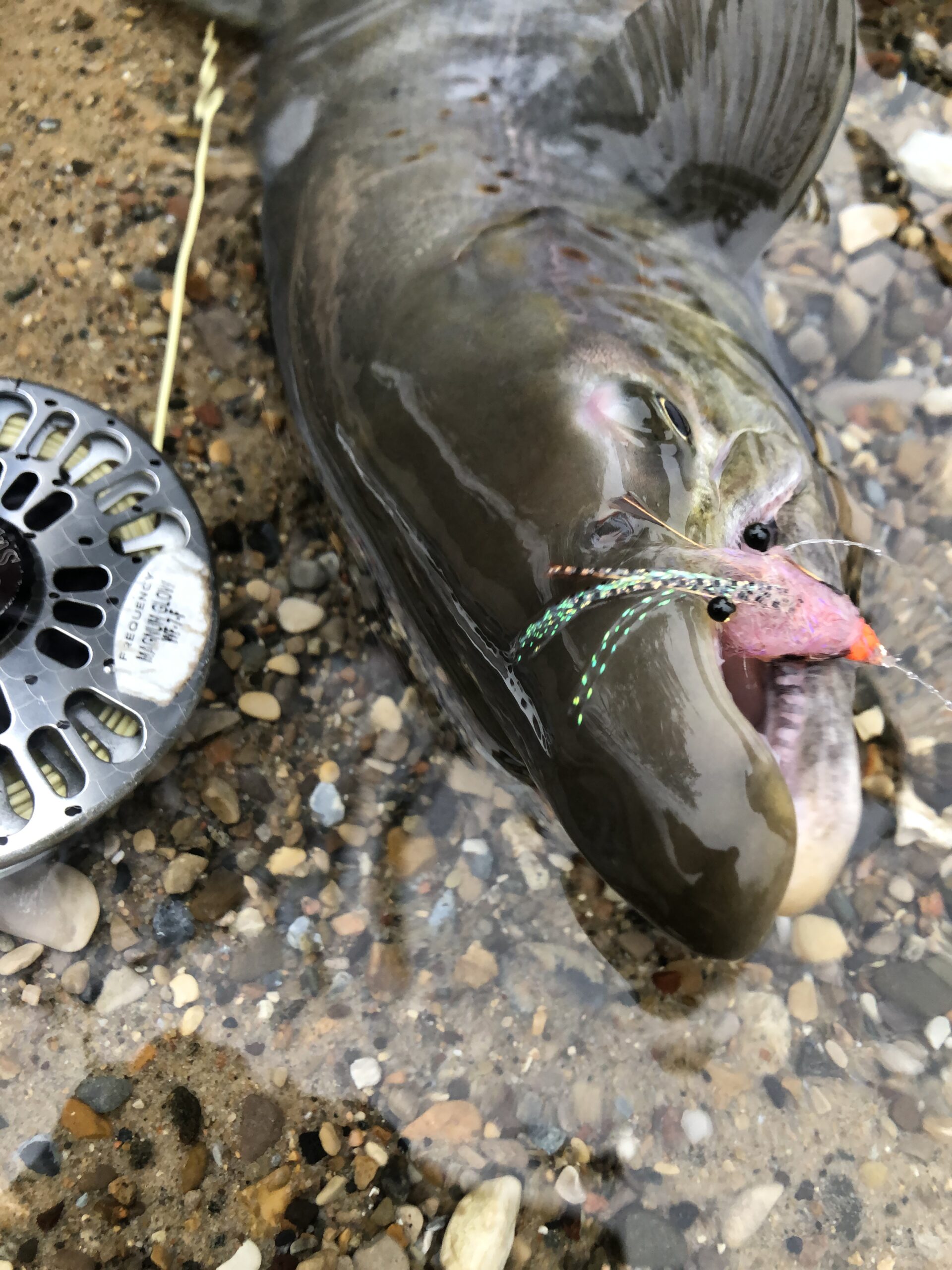
So in summary you basically have three primary attack triggers: predator attacks stemming from the big sea’s prey curiosity, instinctual attacks from natal imprinting from riverine biological drift triggers, and territorial niche and spawning aggression attacks.
THE ATTACK TRIGGER-THE SWUNG FLY
Hugh Falkus in his monumental work “Salmon Fishing : A Practical Guide” stated reasons why a salmon take a fly- the same thing holds true for steelhead and sea/lake browns:
1. Feeding habit-a deliberate take, frequently ascribe to a reflex action resulting from early river life as a parr.
2. Aggression – “the crunch take”- a seemingly automatic reaction to intrusion into the salmon’s territory.
3. Inducement — a response take primarily based on chasing and escaping quarry.
4. Curiosity — a gentle non- take in which the fish rises to or touches the fly with mouth closed, with no intention of taking the fly. ( I have added: Playfulness — dolphin behavior, such as bumping the fly or flipping it with its tail, in which the salmon makes no effort to seize the fly with its mouth. (My “pack hunting” predatorial behavior theory when schooling pelagic bait fish into tight circles)
5. Irritation — a response, usually aggressive, resulting from prolonged aggravation such as the repeated casting over the fish. (My PASSIVE /DORMANT stage from Selectivity)
These so called “strike attack commandants” summarize a good overall perspective how all migratory salmonids respond to the fly. Atlantic salmon, which Falkus was writing about, steelhead, sea run browns and even coaster brook trout strike your offerings from those rules. The only exceptions are the migratory trout i.e. steelhead, browns, chars etc. who can ingest food upon entering the rivers- whereas Atlantic salmon entirely cannot. Yet by my observations the landlocked freshwater Atlantic salmon act more like migratory brown trout in their sustained eating ability’s in migratory river runs. Thus the greater tendency for the biological drift “eat bite” in steelhead and migratory browns and nymphing success.
As we discussed in my Hallowed Waters Podcasts “Below the Meniscus ” Series Part 1: the wet fly swing trigger of the fly sweeping broadside and then upward turning movements of escape, has the most impact for triggering the strike in migratory salmonids when fishing the wet fly swing. However the “upstream-and-across” technique so fully applied on the 1800’s English rivers, and even today, has a very powerful affect on migratory pooled-up Atlantic salmon that we will discuss later. In the initial fresh run phases a swung fly is struck aggressively and with firm resolve- the fish almost always hooking itself. It is struck and captured with the same resolve just as in their pelagic baitfish predator hunting in the oceans or lakes would be. But what I have found of critical detail is the speed of the swung fly that is more species specific than I earlier realized.

Fly speed and its ability to stimulate the attack strike trigger is very much related to the built-in life survival strategy of each species and the comfort levels each species has been gifted with in their predatory attack speeds that have evolved to be most successful. I have learned a great deal about Atlantic salmon behavior watching the attack strike triggers in the extremely clear waters of Iceland, Gaspe Canada, and in Michigan’s Great Lakes and inland glacial lakes, where the water clarity is Bahamas clear. Similarly, summer steelhead and low clear waters have given me insights into their quicker attack speeds than winter fish, all dictated by water temperatures for the steelhead. In Gaspe and Michigan you can watch Atlantic salmon chase and attack your fly from 10 feet out. The amount of chases and refusals after chasing the fly with their mouths open, only to refuse it at the last second; and also coming to the fly mouth open and appearing to take the fly, but not closing the mouth on it , is so frequent it has amazed me and my clients. The amount of this that goes on in the tea-stained Atlantic salmon waters of larger Canadian or European rivers, can only be imagined to its frequency. One thing I do know is that the correct speed of your fly holds up very accurately for the distinct species you are targeting.
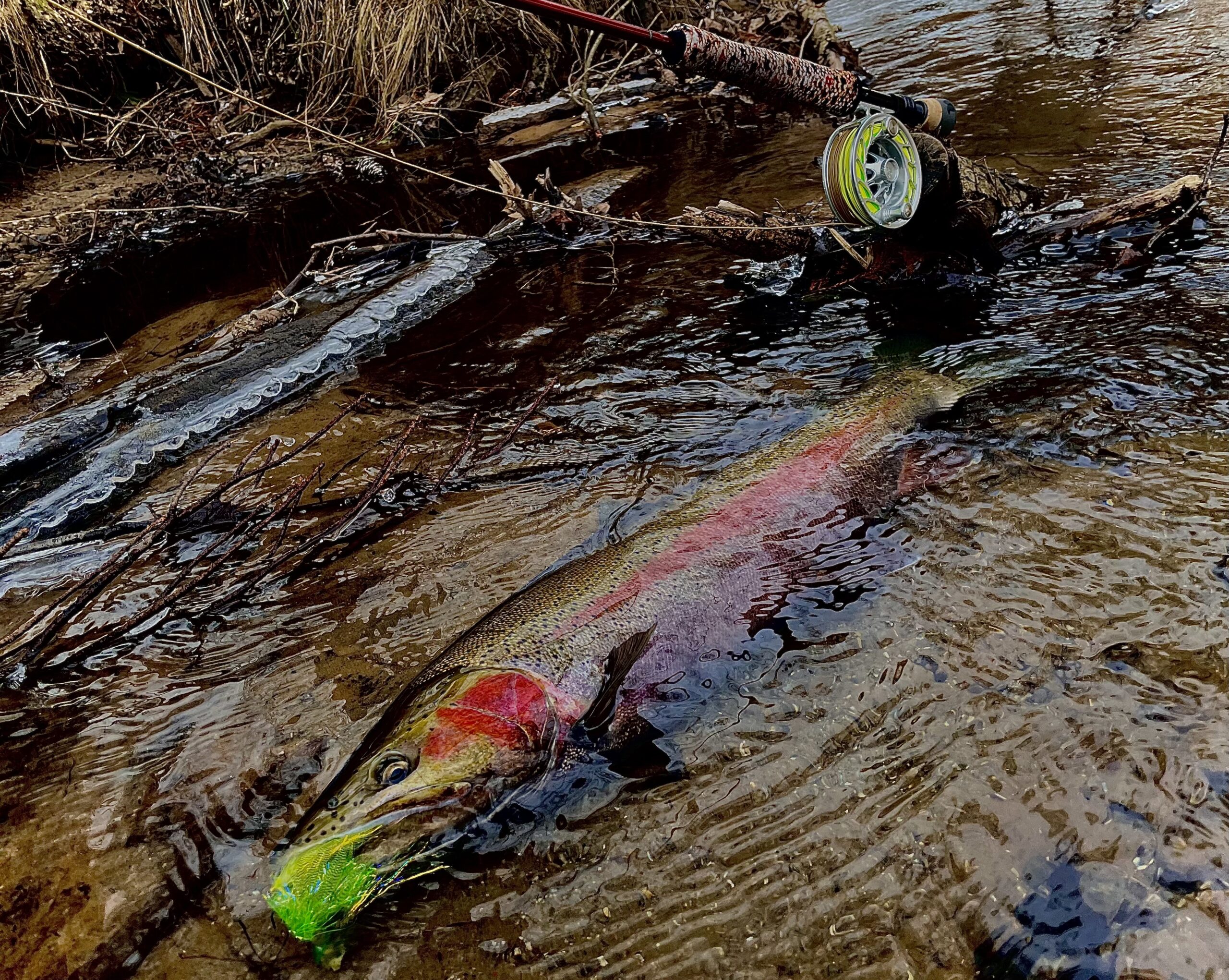
Swung Fly Speed-Atlantic Salmon
Of all the migratory salmonids the Salmo salar has the highest recorded attack speeds – pushing 26 mph. For Atlantic salmon it is the “1 and 1/2-to 2 feet per second” steadily moving fly, with no hesitations away from the fish and beginning to turn and move upstream, which has the most attack triggers in fish holding steadily in current. Secondly, the casted upstream, with a fast sweeping broadside downstream approach, has produced remarkable strikes and chases to pooled-up dour salmon in Canadian Maritime rivers and Iceland, where currents were less due to low water summertime droughts. Fishing Greiner’s Rubber Legged wets on the Gaspe rivers just below the surface, and up to two feet below, with fast streamer stripping techniques, was deadly- the faster you stripped the greater the success, resulting almost in a blistering 3 feet per second speed.
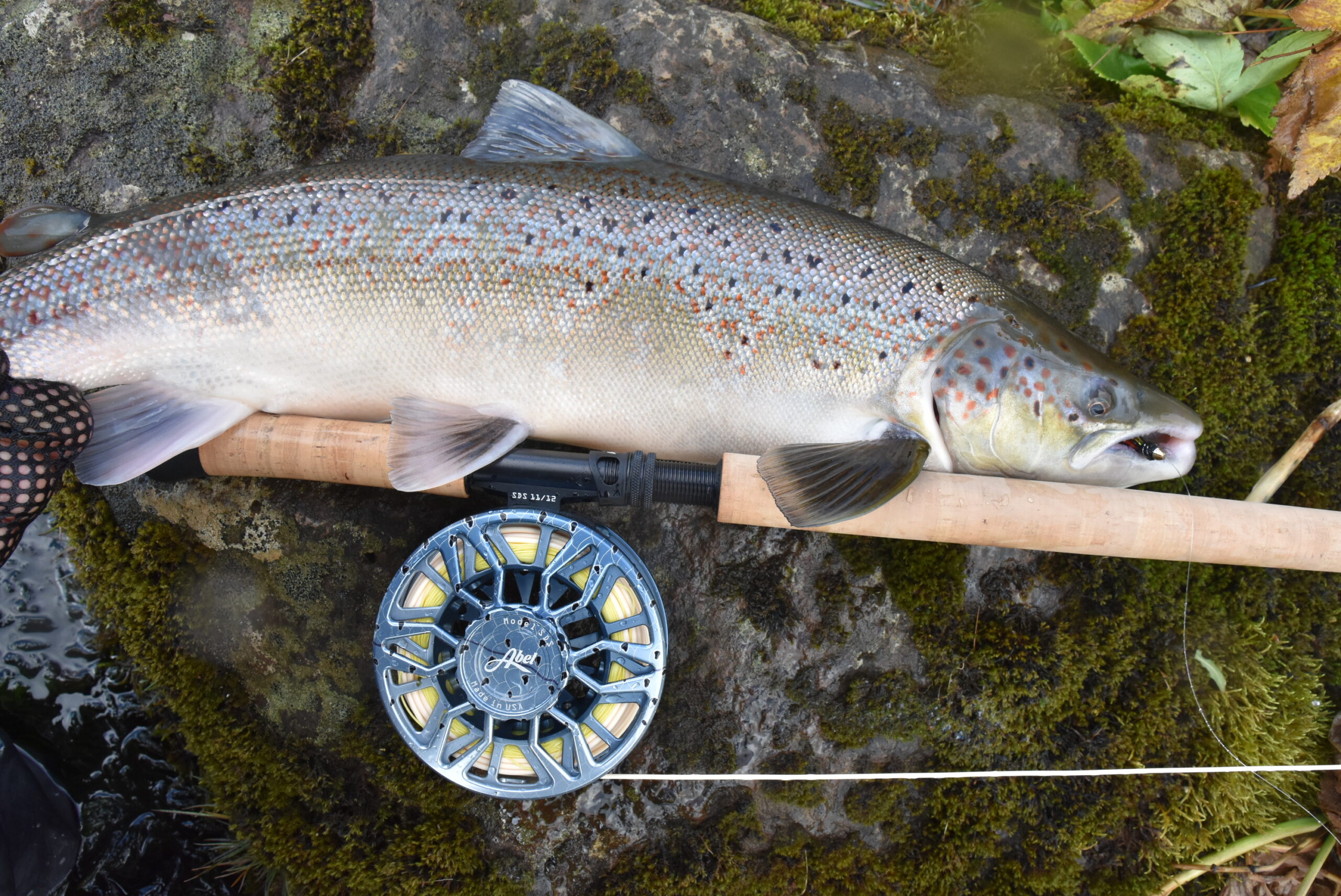
Though the migratory steelhead and browns attack speeds tend to be preoccupied with water temperatures as their main preferences for fly speeds, Salmo salar do not. Regardless they seem to maintain a high speed preference. But given ultimate temperatures in the 45-60 F that elicits those fast attack speeds, the best one can only envision is the need for higher attack speeds necessary in the big Atlantic ocean and seas that has shaped this high attack rapid efficiency. Chasing large schools of speedy baitfish like herrings and capelins; or to escaping fast swimming predators like Orcas, has molded this attack efficiency. Also out of all the migratory salmonids, we see Salmo salar, once it commits to the swing fly, it nails it efficiently without doubts- but it is in the amount of ” commitments ” that poses the biggest obstacle.
Steelhead/Sea-Lake Run Browns Attacks

Being true trout, steelhead and both sea browns trutta/morpha trutta, tend to be more temperature dependent as mentioned in their attack speeds and fly taking quickness, as all trout do out of metabolic conservation. But in more general, their much slower attack speeds between 5 to 15 mph, dictates how they take the swung fly. A more deliberate 2 feet per 2 seconds seems to hold true in optimum river temperatures of 45-60 F. But during very cold winters, and water temperatures below 40F, 6 inches per second or a 2 feet per 3 second speed is necessary to induce them when they hover near the bottom.
Exceptions for steelhead speeds are the summertime running fish of the Pacific Northwest, like the Umpqua and Rogue Rivers and others. Here the warmer temperatures of the water, coupled with high oxygen levels of aerated runs, allow their maximum attack speeds and surface orientation more similar to Atlantic salmon.
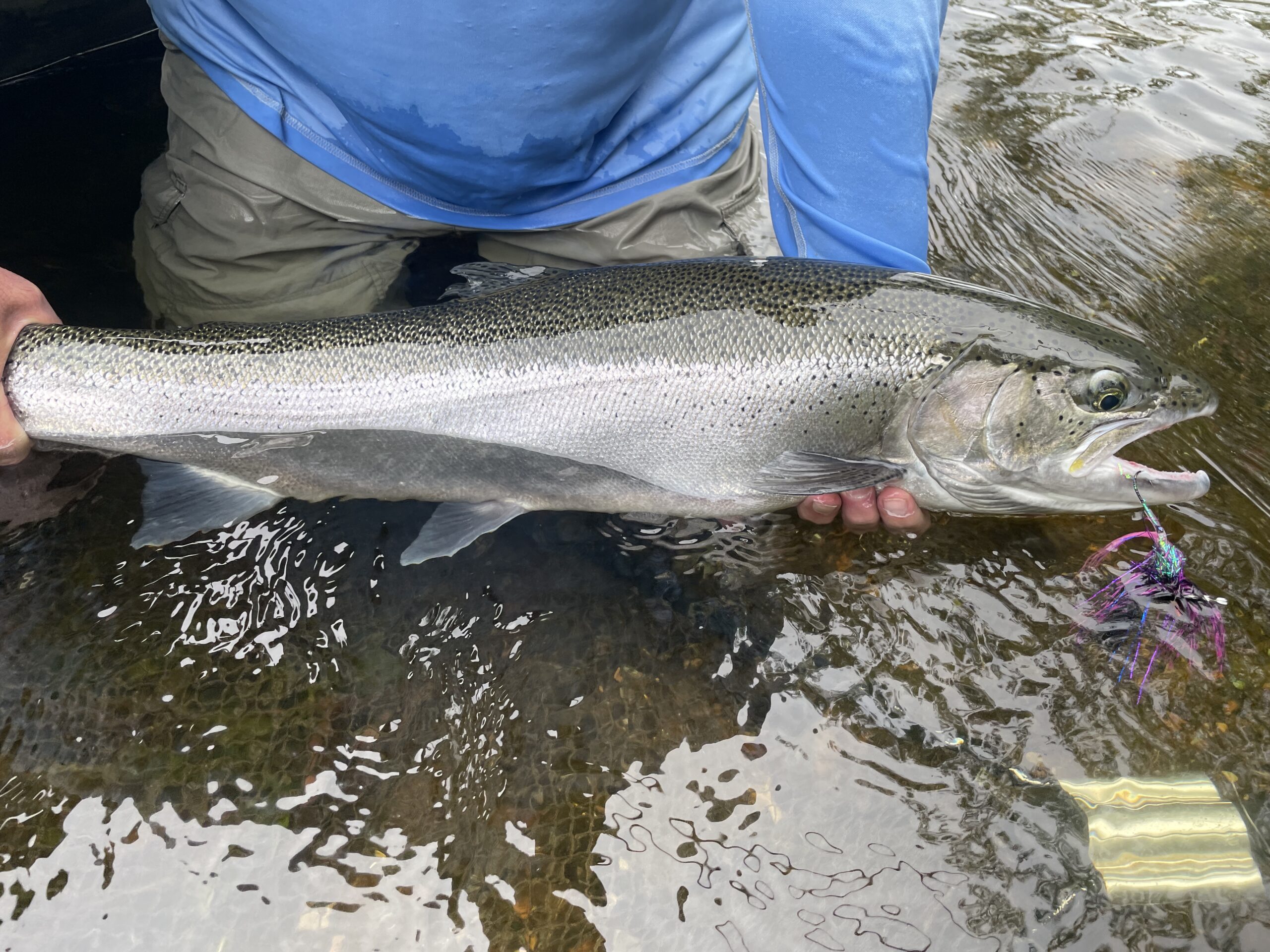
As for sea trout/lake migrating browns, their attack speeds are the slowest of the three. Being opportunistic secondary predators in the big sea food chain, they feed on just about anything and everything that they attack very pragmatically and efficiently. Their swimming shorter distance in the big seas, and being very shoreline orientated near their river mouths of origin, tend to make these more lethargic feeders and attackers often focused on bottom prey such as what my Raccoon Sculpin Intruder imitates, which I mentioned at the beginning of the article.
Prime Niche Lies that Trigger Attacks

Moving fish and spawning fish tend to be the worst attackers in my experience. They tend to be preoccupied with the task at hand which is travel and procreation. It is the holders in the prime taking slots that are the most anxious attackers. Just as a trout in a stream has “the prime seat in the restaurant” niche lie occupied, it protects it at all costs- so are these prime lies guarded. These are fulcrum intercept points where the current and river benthic and shore structure align for the ideal glide to inspect food offerings, and allow for flow comfort in the bubble-line current as it feeds food curiosity opportunities in the bio-drift replenishments. In migration, these holding lies allow for metabolic conservation, while offering protection and abilities to slide in and out of creases/seams when the fish chooses. They provide ideal viewing areas of a fish’s surroundings and also thermal comfort, when in larger deeper pools at the bottom of gradients that have closeness to spring-seep sources in both winter and summertime.
Ideal Taking Lies For Atlantic Salmon / Steelhead/Migratory Browns
Here is a list of prime taking lies:
Pocket water/boulders- Deep Long Pool Guts- Outside of Long Riverbends- Tight to Rocky Shore Structure- Forks of a River- Head of a long Cascading section of River- Pool Tail outs above Boulders – Pools directly below Spring Sources or Cold Entering Brooks- Above and below Bridge Abutments- Tail outs of Water Falls – Gravel Bed Shelves/ drop-offs–Shale shelves–Hydro dam pools- Above and below divided River Channels–Undercut River Banks
Sea/Lake Browns Lies
These are very similar to Atlantic Salmon and Steelhead lies but mostly in slower currents with depth. They are also fond of structure like wooded debris/large boulders etc. similar to river brown trout. Their tendency is to like slower frog/sucker-water and shallow flats with slow currents in river estuaries, thus making them unique and often pose presentation challenges where flies must be swung/stripped/jigged rather than traditional wet fly swinging in currents. Also, they like a general overall slow 2 feet per 3 second fly speed.
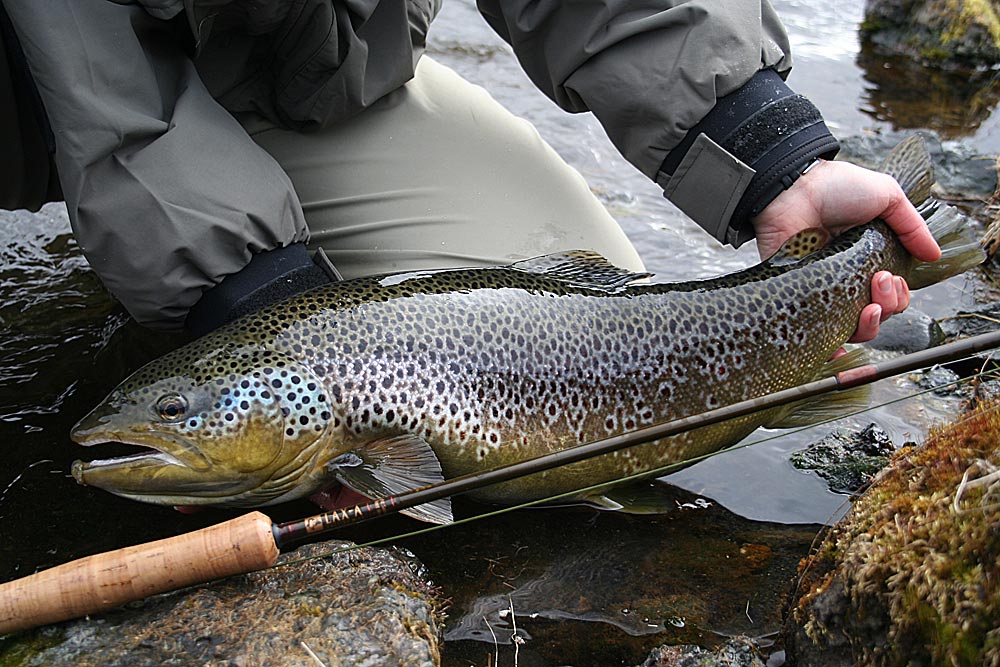
Curiosity
The curiosity index is where many looks by the fish to different flies occurs yet refusals happen. This tends to be highest for Salmo salar and less for steelhead which are more aggressive in their resolve. Like a brown trout they can be very finicky and also take flies that are totally radical from what are commonly accepted proven patterns. Thus the salmon’s and summer steelhead’s preoccupation with nosing-up to colored leaves on the surface in fall, and other bizarre traits like continuous follows without a take -even with their mouth’s wide-open for the kill- only to refuse it. This justifies all the bumping of the spey flies/intruders/tubes on the dangle short takes. Like a cat and dolphin, Atlantics and steelhead like to play with their food in some bizarre sense.
Steelhead display similar curiosity qualities to Atlantics but tend to be less critical of presentations, and either take or refuse the offering pretty consistently. Their desire to “eat” remains much more intact for longer periods in the river for up to 6 months due to the fact that they are true rainbow trout. True indigenous ocean steelhead tend to be faster and more aggressive attackers than lake rainbows, most likely as a result of the thousands of miles they travel at higher speeds in the oceans. But also ocean fish, because of the regulating of salinity in the renal system, have a greater tendency to go off the bite quicker and longer than lake run freshwater steelhead.
As for Sea Brown Trout the slow and thorough “kill-it” mentality of a true brown trout prevails and has curiosity with every food form it could fit into its mouth happens. They could also go from super aggressive to completely dour/ passive in a flash. They have also been known to be caught more than once in the same day- they can be insatiable beasts.
Prey Triggers/Colors
Without writing a major treatise on what colors and silhouettes a trout or salmon sees, let’s review a quick refresher of optic basics for Atlantics, steelhead and sea browns.
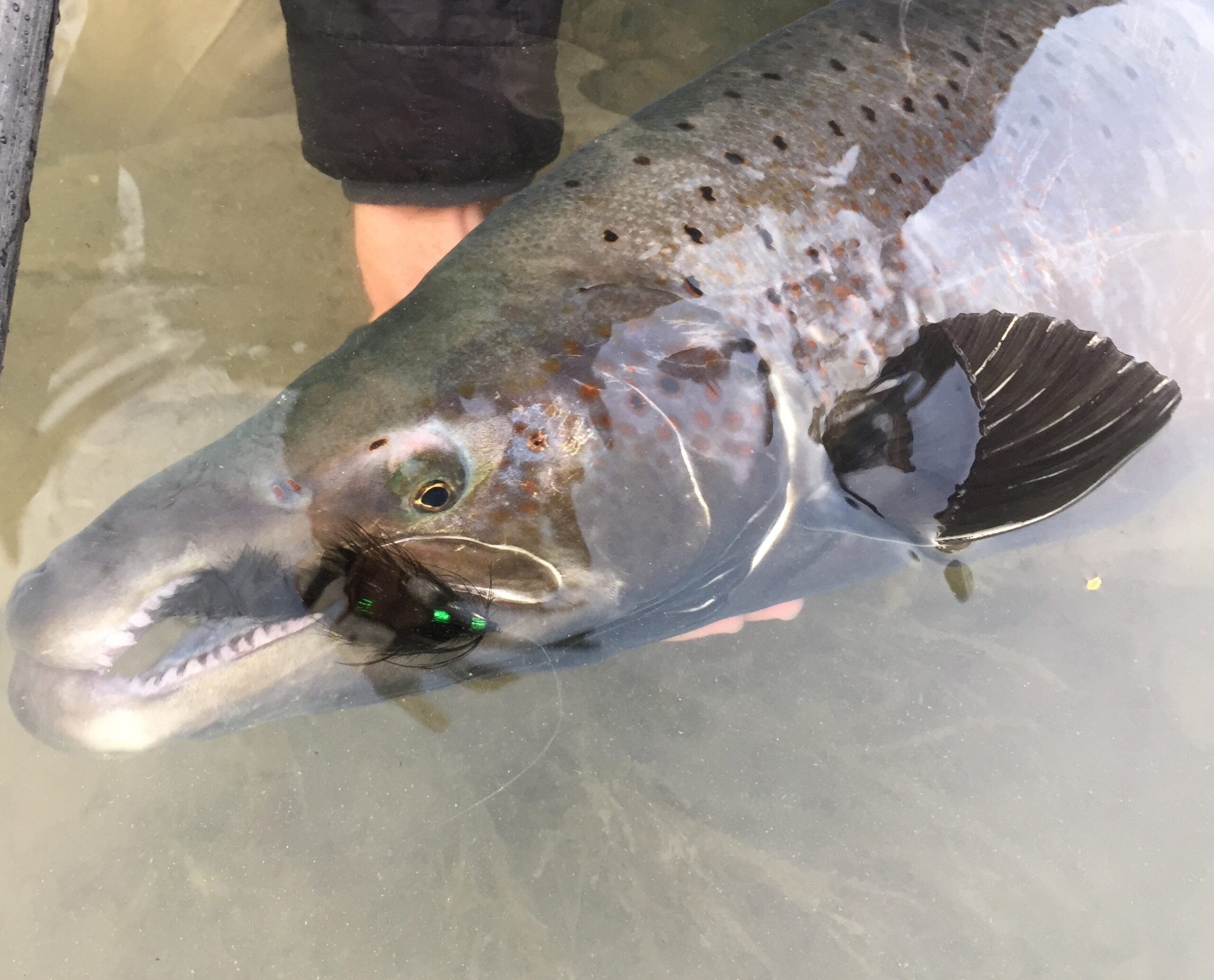
First and foremost scientists really don’t know what a fish sees referring to the image their brains sees. The interaction between water and light is the distortion factor known as attenuation, which changes the intensity of the light and color. Two processors: scattering and absorption, change the way color appears at various depths in viscosity/clarity. So the deeper we go, the color red will eventually appear bluer and then culminating in black. The new florescent and UV materials utilized so significantly today, totally alter the standard color scheme when light interacts with water- thus adding hints of these materials to modern-day flies have become extremely lethal.
So in shallow waters, with plenty of light as in a riffle of a the river, the colors of your fly will appear pretty much as they do without water, and will gradually diminish towards the dark blue / black spectrum . Without getting intricate into all the hundreds of studies that have been done, it is clear that certain fish prefer certain colors and this has been the overriding motif over the past centuries in designing Salmon flies. Research has also shown that very little light is necessary for steelhead, Brown trout, and Atlantic salmon to see color as we see it. But one thing for certain- silhouettes and shapes will show up, even though they’ll will eventually be black at deeper depths or night situations. It continues to amaze Atlantic salmon anglers how extremely sharp Salmo salar’s vision capabilities are. Having monocular capabilities with rods and cones, they see color and movement in a hyper selective fashion. This may account for the success or failure of the thousands of Atlantic salmon fly patterns and their variations on a theme.
In the prologue of “Leaper”, written by Joseph D. Bates Jr. / Pamela Bates — Richards, they discuss “why all the fuss”, about fly design and put it into layman’s terms:
“If salmon will take such diverse items as bugs, insects, berries, sweets, worms, and even cigarette butts, why should we be so fussy about offering them carefully dressed artificial flies in particular colors, shapes, and sizes selected to suit the conditions of the water, temperature, and so on? There is simply no pat answers — variables are too numerous and species to unpredictable. This is fortunate, because conclusive answers about fly selection and presentation methods would diminish the fun of fishing. The best one can do is to try to deal with varying conditions and likely response, and enjoy the challenge of discovery. Years of personal experience and reading the extensive angling literature can provide valuable insight”
The traditionally proven patterns, which often mimic biological prey in rivers streams and seas, tends to be changing at alarming rates due to climate change and changes in prey /predator relationships. Imbalances and shortages in traditional prey choices causes big water species to seek out other less commonly used and once inaccessible prey forms. This also is further complicated by the abnormal weather patterns causing up and down cycles in prey abundance, from severe or mild winters; to droughts and heat waves, wreaking havoc on big water temperature regimes.
The Power of the Black Fly
Provocations by bigger fly patterns/intruders /tubes with more brighter iridescent tones are more customary for ocean going steelhead. Here large crustaceans /squids etc. can trigger more pink/orange and iridescent blue/purple preferences. However in Atlantic salmon flies hints of fluorescent colors- especially during fall and pre-spawn with black (Undertaker etc. ) tend to work more subdued in display. Sea brown trout and Atlantic salmon consistently focus on duller backdrop colors mimicking riverine prey. Black seems to be the eternal ignitor in all migratory species patterns used as a backdrop theme in combination with brighter colors.
Thus the common thread in the relationship between Sea Browns, steelhead and Atlantic salmon is there ferocious appetite for things black, as the highly successful black wooly bugger- even the noble Salmo salar has been known to take that common trout fly. The Salmo’s in particular are known to be elite kill artist predators-rarely once prey is targeted do they not have resolve in the take. And most of the time they rely on their sensory and smell capacities along with a developed sense of vision to target their prey much as do sharks. Studies done on sticklebacks for instance have shown that a passing red car going past an aquarium tank, will stimulate the fish, which can be attributed to the male sticklebacks red bellies correlating with arousal and sexual aggression. The spawning colors of red, pink and orange stimulates an aggressive response to the optic nerve of salmon, trout and char. But what is important to note when looking at a very complex fly pattern as the Jock Scott, is how the blending of all those colors will produce a hue or tonal effect to the general impression that eventually reaches a salar’s vision and brain. Thus black is the least transparent color but highlights the best silhouette and clearly the most visible color for fish no matter at what depth.

Since the Jock Scott’s inspiration, so many similar color motifs in feather and hair wings have come along like the Black Dose, The Sir Richard ,Syd Glasso’s Ballyshannon, Crosfield Black Silk, the Dusty Miller etc. – just to name a few. All incorporate a black under tone background theme with the Jock Scott-like color. The early Spey and Aykroyds incorporate a dark/black/brown theme like the Lady Caroline, Grey Heron, Carron etc.
But perhaps the deadliest modern day fly that touches on the Jock Scott dark/fluorescent reddish spectrum is the Willie Gunn, invented by the Scottish Ghillie of the same name. It is particularly lethal in dark tannic stained color waters like Scandinavia, Canadian Maritimes, Scotland and Russia. Along that theme, The Lord Mayor of London fly by Megan Boyd, transmits that powerful orange/ yellow spectrum similarly. They are now tied in hair wings, tube designs and as Temple Dog designs, which is reversed tied hair pushed back for movement and water displacement. Today’s modern guides carry boxes of them.

In those same boxes you will find another equally lethal fly based on the same color motif-the Undertaker mentioned earlier. Tied by Warren Duncan of St. John, New Brunswick, if you die and go to salar heaven, and had but two flies to choose from for eternity, it would be the Undertaker and the Blue Charm. Along the blue-green spectrum the blue charm, with its affiliates the Hairy Mary, Laxa Blue, Sheep series , Crosfield, and of course the Green Highlander , these are our favorite early-season flies when the blue-green spectrum is most dominant as fresh chrome salmon arrive from the salt as do fresh run spring steelhead-purple being added to the mix for Mykiss .
The fly colors and their strike triggers are very closely tied to the types of waters migratory salmonids migrate up. Tea stained colored waters will favor bolder color pairings like a Willie Gunn’s orange, black ,and yellow/chartreuses. Copper is also big for tea-stained waters. Glacial calcium carbonate, blueish green waters, will favor the obvious green/blueish spectrums with black and purple.
Phases of the run as mentioned earlier are closely tied to attack prey triggers. Fresh run ocean/lake fish are keyed into the UV light spectrum of the upper 50-75 feet depths of the big water that blue/green preferences hold true in. Later in shallower riverine environments, the red/black spectrums tend to be favored and as the fish nears spawning. Also aggressive optic triggers of pink and blood orange red cheeks, and body colors, stimulates those color receptors in their rods and cones as mentioned earlier.
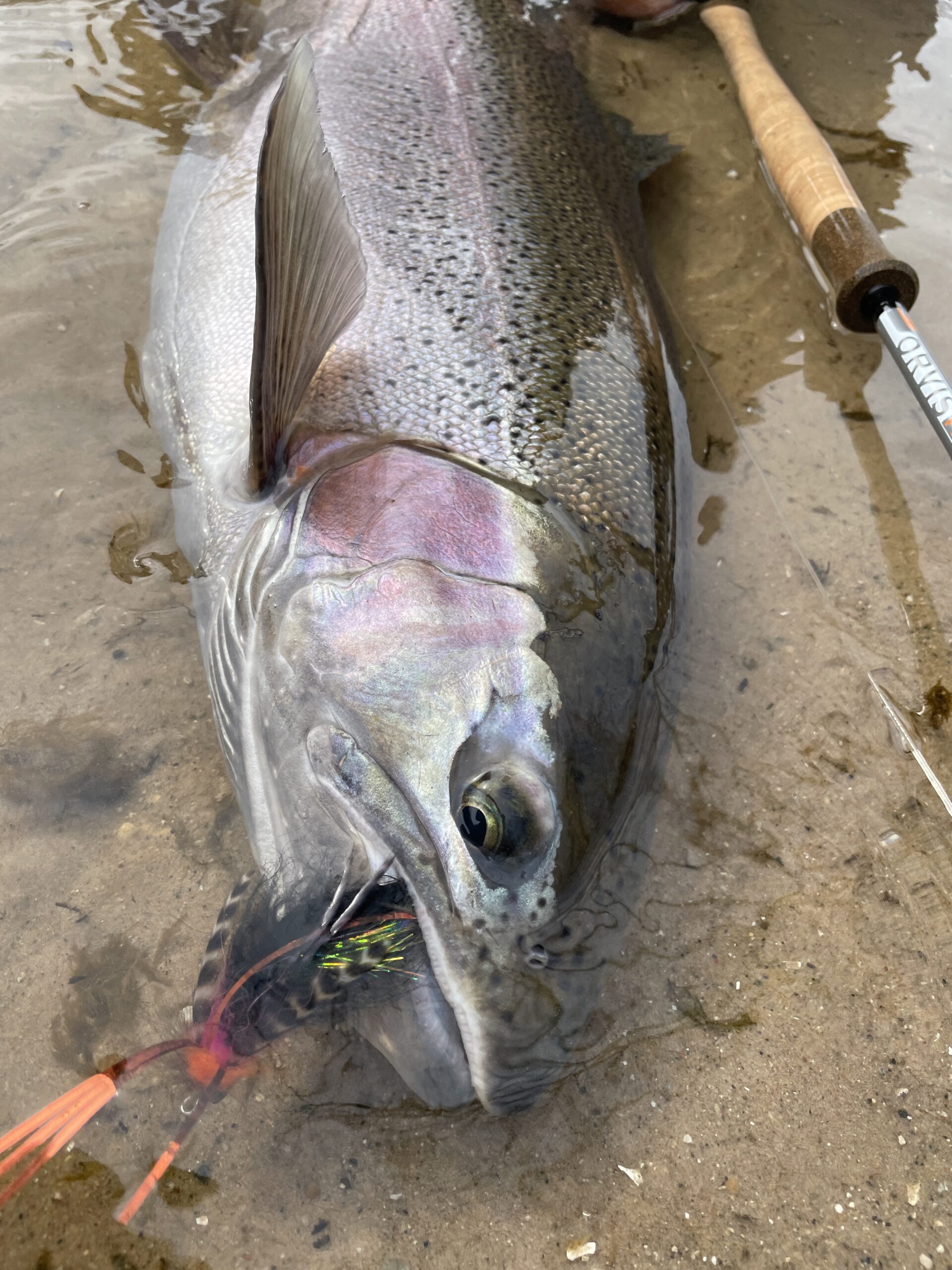
Perhaps no other venue has seen changes in their prey/[predator relationships than the Great Lakes and also other seas and lakes around the world. In the Great Lakes so many new exotic invaders have changed the micro prey food chain. Thus historic prey like Rainbow Smelt are almost non- existent as sticklebacks, shiners, perch, gobies, sculpins, Hexagenia nymphs’ etc. have replaced the more traditional food forms like Mysis shrimp, which have declined drastically. This translates into more V-shaped fly bodies with barred markings and green/brown colors- verses the bright silvers. Also the color of the waters have become extremely clear due to the zebra /quagga mussel invasion. Thus anglers are using subtle UV iridescent colors and sparser patterns. In one lake and river chain I fish for Atlantic salmon, Chironomid midge play a very large role in Atlantic salmon foraging like they do in Iceland on the Big Laxa, which their tiny-tubes emulate. Overall advice is to be creative in fly designs and use traditional pattern motifs and incorporate new twists and prey suggestions like my Racoon Sculpin does .
Managing Fly Speeds and Depths
There are so many new specialty boutique lines/tapers and density compensating sink tips , long and short Skagit, Scandi and traditional long belly lines available today to make your head spin- all promising to deliver your spey launch into fish more efficiently. Rio, Airflo, Scientific Anglers, OPST, and so on have awesome new lines they have introduced. But a traditional understanding of proper upstream and downstream stack mending, greased line mending, and elevations of rod tips to penetrate the buckets and deeper holding lies are necessary. These are all used in combination with stepping down the run and slip feeding the line during the swing for increased depth and slowing down the speed- all vital and elementary in controlling fly speeds and depth. Raising, and then dropping the rod tip allows for more depth penetration, followed by greater surface tension to speed up the fly and ascend it in the broadside sweep at the end of the drift, is the best way to penetrate the taking lies and use inducement methods, which can trigger hard strikes. If the new lines deliver on their quick and easy casting performance promises, so much more the better.
Several things to note that will help you better understand the take and locating fish. If you are swinging flies in water where the fish are not visible, you must envision where the fish are holding by where you have experienced takes before and caught fish. Study the riverine elements that align to make that place a prime taking lie and look for others like it. Also, envision how your fly will be approaching that taking area by the depth of the water current velocity, based on how your sink grain and heaviness of the fly will interact and get into the strike zone. How you position yourself will dictate how the swing will be approaching the lie- preferably on the broadside swing trending upstream in the traditional wet fly swing.
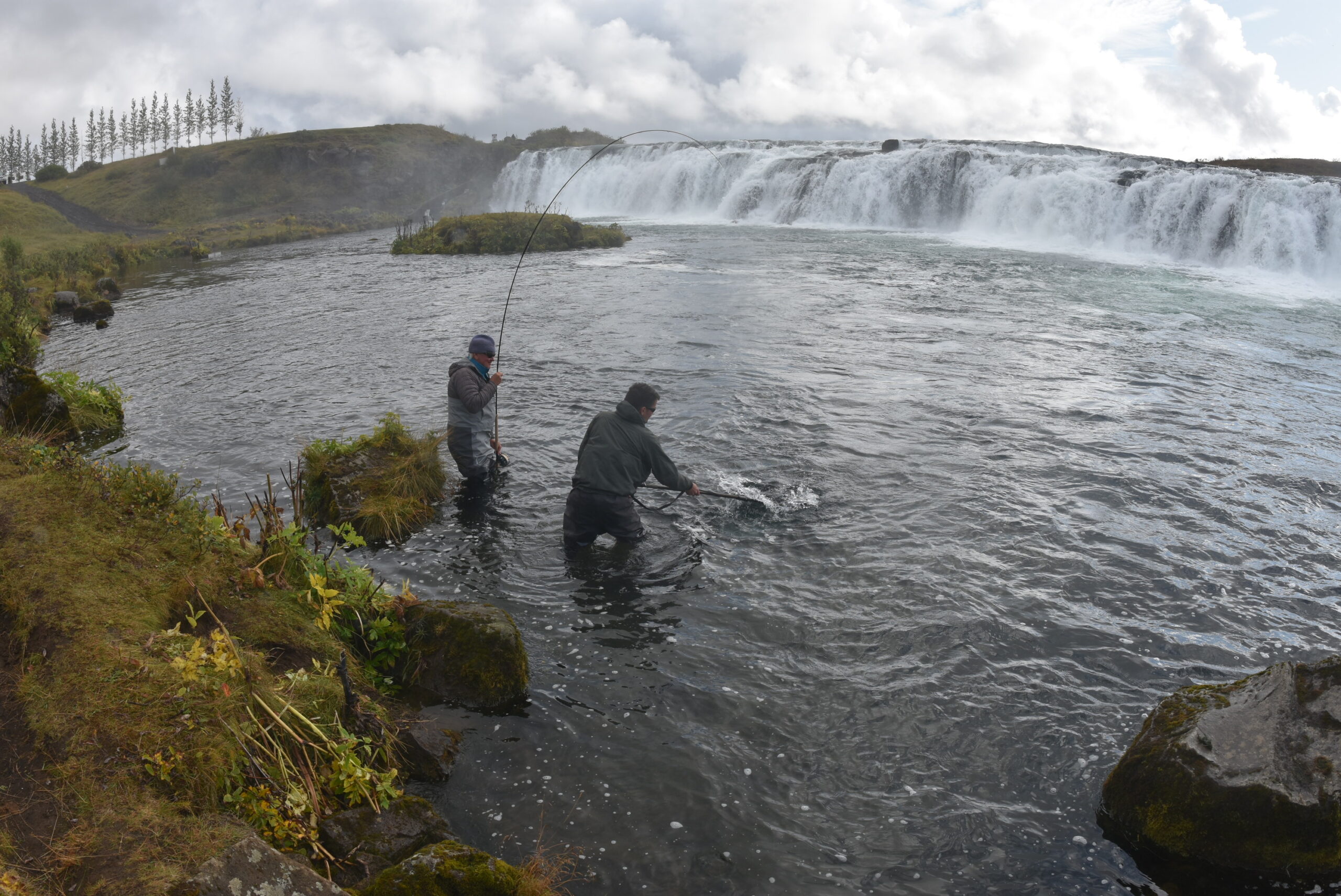
One thing we tend to over emphasize is getting down to the fish. An aggressive fish that is most likely to take your fly will be inclined to move good distances to take it- and higher up in the water column. Yes, in very cold Great Lakes winters -especially for steelhead, we must often bump them on the nose with very slow, deep fly speeds. But Atlantic salmon especially are less effected by water temperatures and more willing to chase the fly to the surface like they do even in cold Scottish winters for springers.
Adding movement to your swung fly like “pumping the rod” horizontally when the fly is on the dangle- or jigging/stripping the fly on the dangle and swing for sea/lake run browns, is often the game changer that makes a world of difference. Tying a Riffle Hitch in tiny tubes for Atlantics and smaller Spey/ Dee flies like size #10-14 Blue Charms and other traditional sparse ties often makes a difference in recalling aquatic insect triggers. This works well especially for passive/dormant dour fish in summertime holding pools and on rivers that have stonefly, caddis and midge populations, where these natural insects have tons of movement.
Hook- Setting Caution
A classic fly take on the swing is perfection- the fish hooks itself and is screaming into your click-pawl drag beautifully. But we are all inclined to set the hook out of sheer reflex reactions- and in slower currents often necessary. As of hook setting, when fishing the swing one must be aware of setting too early; or setting the hook at all and blowing the hook-set. Riffle-Hitched flies almost always set the hook by themselves since the right angle knot slips off in the hook set and the fish is perfectly hooked in the side corner of the mouth. The stoic writings of the Scottish ghillie Jock Scott said, “to allow a slack loop of two to three feet necessary for the Atlantic salmon to take the swung fly in calmer waters”. Since salmon and steelhead tend to take the swung fly when the fly is under drag and swinging properly and at the right speed, most often no hook set is needed But just as assurance a “slip loop” in the rod hand allows for a little cushion and slack to allow the fish to take-and-turn on your swung offering. Of the two, Atlantic salmon and sea browns are more firm takers than steelhead, which can bump and nip your fly like a trout on occasion. But when a steelhead is hot and chromed they destroy your fly and are in the air before you know it!
One note of extreme importance and rarely mentioned is the “insurance set” for big kyped migratory bucks- a quick horizontal jab set, once the fish is hooked, sometimes helps keep the hook deeper into those very boney/cartilage mouth’s.
Ultra Clear Waters
In extremely oligotrophic calcium carbonate /spring influenced clear river waters, fish are put down by lots of factors and often must be coxed more in these waters with repeated presentations and changed up techniques, varying speeds of fly patterns, and resting the fish between presentation intervals. Rivers like the Bonaventure in Quebec, Big Laxa in Iceland, and some Great Lakes rivers, fish can become extremely spooky and alarmed by bright gaudy fly line colors and dense sink tips. Fish holding deeper especially have greater visibility than surface holding fish due to refraction properties. Slight winds and ripples on very flat clear waters help lessen that effect . Using clear Airflo and other sinking and floating Poly Leaders attached to sinking grain heads make a world of difference along with Fluorocarbon tippets. The Poly Leaders allow you to turn over the flies properly in your tight loops, whereas just adding more tippets collapses the flies. Also less depth penetration is often needed with greater visibility and more surface orientation takes on top.
When swinging wet flies and fishing dries on single handed rods in these extremely clear waters you can’t go wrong with Cortland’s clear Flats Taper Liquid Crystal Floating lines that have little memory and perform very well with total stealth.
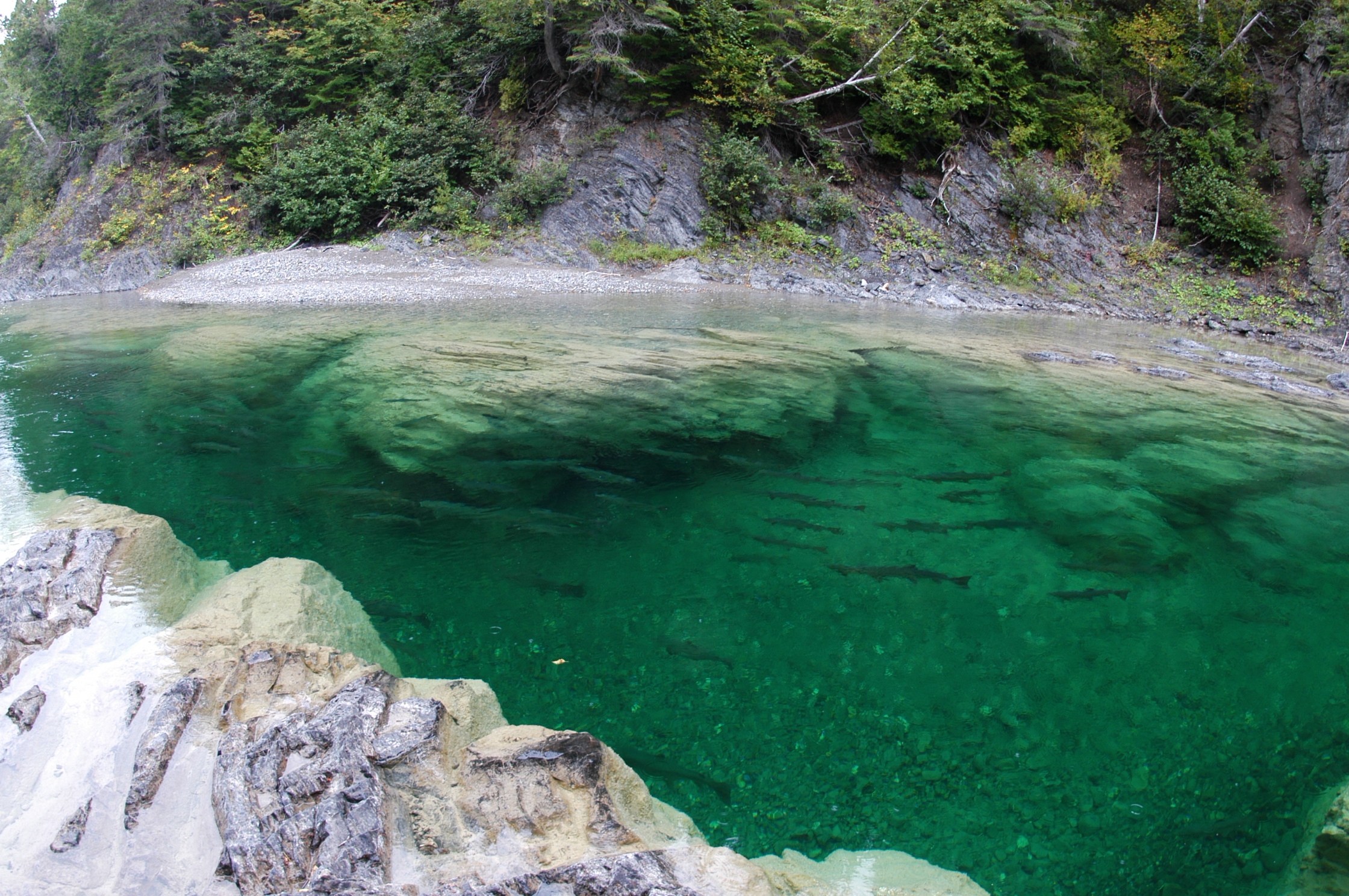
The Drift- Sit and Wait Takers
The 1970’s hunt for Great Lakes steelhead and lake-run browns brought about the deep water “trout nymphing ” concept, originated as “chuck-and-duck” using running lines/pencil lead back on the Manistee River by Schmidt/Richards- it still holds very effective today along with indicator nymphing. West Coast gear and bait anglers have always known that aborted eggs/spawn sacks have always been effective for steelhead/rainbows of the Pacific Northwest. When they were introduced to the Great Lakes, the “egg” concept of yarn flies “glo-bugs’ was combined to include river aquatic insect imitation nymphs, which fertile Great Lakes rivers have in abundance with caddis, mayflies, and stoneflies, since they are fertile resident trout waters. Thus for all practical purposes Great Lakes steelhead are lake-run rainbows and the lake browns are treated as river browns They have a very long bite trigger window once in the rivers and feed on the biological drift from their prey association triggers as parr. The re-introduction of steelhead, with the Pacific salmon experiment of the Great Lakes, allowed for steelhead and browns to come in and feed on the plethora of salmon eggs on their fall runs.

Sit and wait predation rainbow steelhead and browns do very well has thus instituted the drift techniques. Today Indicator nymphing, Center pin fishing, and chuck-and-duck, all use the same methods-drift fishing. Since spey swinging is fairly new in the last 30 years to Great Lakes steelheading, you have two very split schools of fishing: swinging and drift nymphing. Both are very effective with drift fishing being much more results/numbers oriented. Yet those that swing refuse to go any other way due to their addiction for the “tug is the drug” and the nirvana of the beauty and rhythm of the cast.
Migratory steelhead and browns set up crucial taking lies in the bubble line seams in pool buckets and expose themselves to the biological drift. This is more prominent on smaller, fertile, spring- fed trout streams like the Bois Brule, Little Manistee and Ontario Tributaries. Attack triggers for aggressive steelhead likely to take a swung fly usually occur in tail-outs, outside riverbends and random shallower and medium pocket water current runs and pools, where they roam at a greater capacity and freedom to attack the fly, and are not bound to specific river current tight boxes and buckets like on smaller streams.
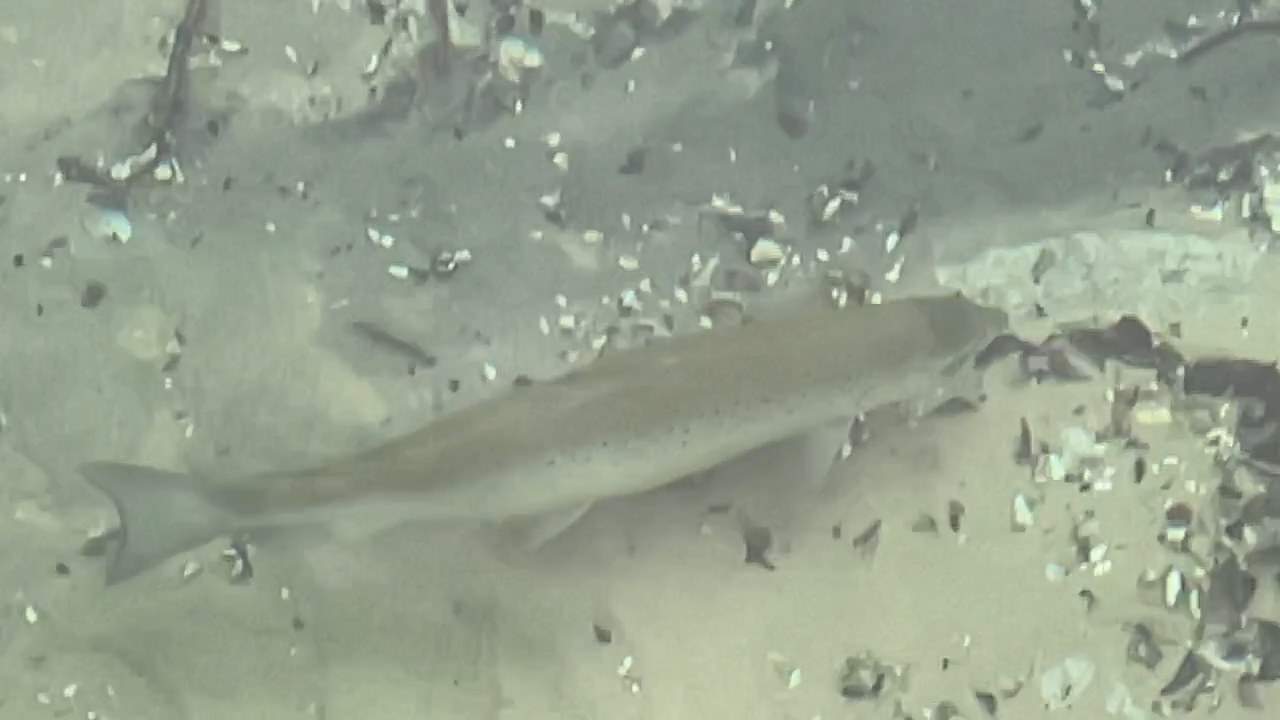
Attack triggers are obviously the biological drift and suggestive food forms when they were still actively preying in the big waters. Egg patterns are deadly for rainbow steelhead and sea browns- but very ineffective for Atlantic salmon. Bio-drift items as caddis and midge larvae, Hexagenia mayfly and stonefly nymphs, and leech/ bugger styles always work. Baitfish patterns such as sculpins/ gobies/perch/sticklebacks etc. and shiners/smelt are deadly.
Attack speeds and takes in the drift zone are in tight quarters like trout feeding efficiently. Usually no more than two ,and sometimes maybe three feet, is the max a sit-and-wait attacker will go to take a fly from a guarded lie. Thus fishing the pool buckets and riverbend/tail out taking lies thoroughly in 4-6 foot lanes and channels is necessary to cover the drift- since not all fish sit directly under the bubble line. It amazes me how many anglers cast to the same spot over-and-over.
Sun /Moon/ Barometer
Many anglers think these factors are folklore-that’s rubbish! Cloudy days and low light conditions are usually the best for migratory fish that spend their time foraging in dark deep sea waters. Nature revolves around the solar factors and has key signals it gets from them- sun angles being one of the most powerful for the bite. Also diurnal cycles of migration of bait fish with plankton blooms and Mysis shrimp also play roles in feeding timeclocks of predation. It is uncanny how the angle of the sun at 11 AM, no natter where I am, triggers a bite. Perhaps it is it the way it hits the water; or another ingredient like it warms the water up on cold season days. High sun can also influence the vision of the swinging fly against the surface when fish are going up to take it. It usually has a negative influence since it scatters light and makes the fly impossible to see. Also, check for shadows bouncing around from you or your boats profile if fish are in very clear waters and you are elevated. Fishing first light and last light are also powerful bite windows.
The moon is perhaps the most powerful. The full moon has the ability to reduce melatonin in fish from the light influence in the pineal gland that produces rapid around the clock upstream migrations and fresh fish coming into the river. The lunar calendar also influences tides and estuary water levels critical to newly migrating fish. Fish stuck dour in a pool become attack oriented again when they move -up several pools or runs. Also some say gravitational influences on fish we still do not fully understand have natural influences beyond our human understating.

As for barometric rapid changes this is without doubt the strongest influence that effects the attack mode and triggers. You can see the behavior of migratory salmonids change as fast as the weather does. In big lake/sea angling and lower in the estuaries the change can stir the fish into the attack since in deep water the effects of compression from pressure on the air bladder is less than in shallow river environments -thus taking the bite into full drive due to low light and stirred water making bait easier to hunt. But higher up the rivers system. as the gradient gets higher and water shallower, barometric changes effect the air bladder as pressure squeezes substantially. You can see the effects of pressure quickly as fish come to the surface to gulp air ; or lay dormant and not moving. If you have the luxury to pick a day to fish stable pressure systems are ideal- either low or high. I personally prefer high pressure.
Dry Flies

Dry Flies for Atlantic salmon and summer steelhead have long been a magnificent way to catch these migratory beasts that have a strong disposition for focusing on the surface from their riverine parr life chasing aquatic and terrestrial insects. Since summer steelhead and Atlantic salmon tend to be the more interested fish in the dry fly game the water temperatures at that time of year are 50-60 F ideal. The most popular are dead drift presentations ,down-and- across waking in the swing, and straight downstream at an angle, then fast stripped and ripped upstream for summer steelhead.
Fall steelhead on the Great Lakes rivers have tremendous potential for the dry fly but are rarely explored. October caddis hatches have the most success to get fish looking up- especially in shallower rivers and with wild fish. Rivers off of Erie in Ontario, with their wild steelhead, tune into October caddis hatches with ideal water temperatures for the dry. The Cattaraugus in NY has that potential also but is often murky and off color when the fish finally come in. PA/OH steelhead in often very shallow drought ridden waters can be coaxed into taking the dry fly when they are very congested in numbers and fighting for territorial dominance and river lies. Here fish that are agitated and usually at the tail outs of the pools are the usual players.

And finally Michigan shallow and gravel tailwaters like the Muskegon and Manistee have the greatest potential. In 2022 my clients and I had 6 adult and grilse steelhead come and take the dry that were in shallower water behind spawning salmon and in feeding caddis water .
The attacks of the dry are often very deliberate and slow with refusals and lots of curiosity. But at times they attack the fly with a vengeance and usually miss the fly, especially when you are lifting it up for the next cast. But one thing is for certain: whether we are on a Canadian Maritime river, the Umpqua, or the Great Lakes- we tend to choke and take the fly out of the fish’s mouth before they can take it, since we often are so astonished when we see the mouth coming to the surface to take it. Patience and self containment are easier to say than deploy. Regardless, it is a challenging and exciting way to pursue migratory salmonids.
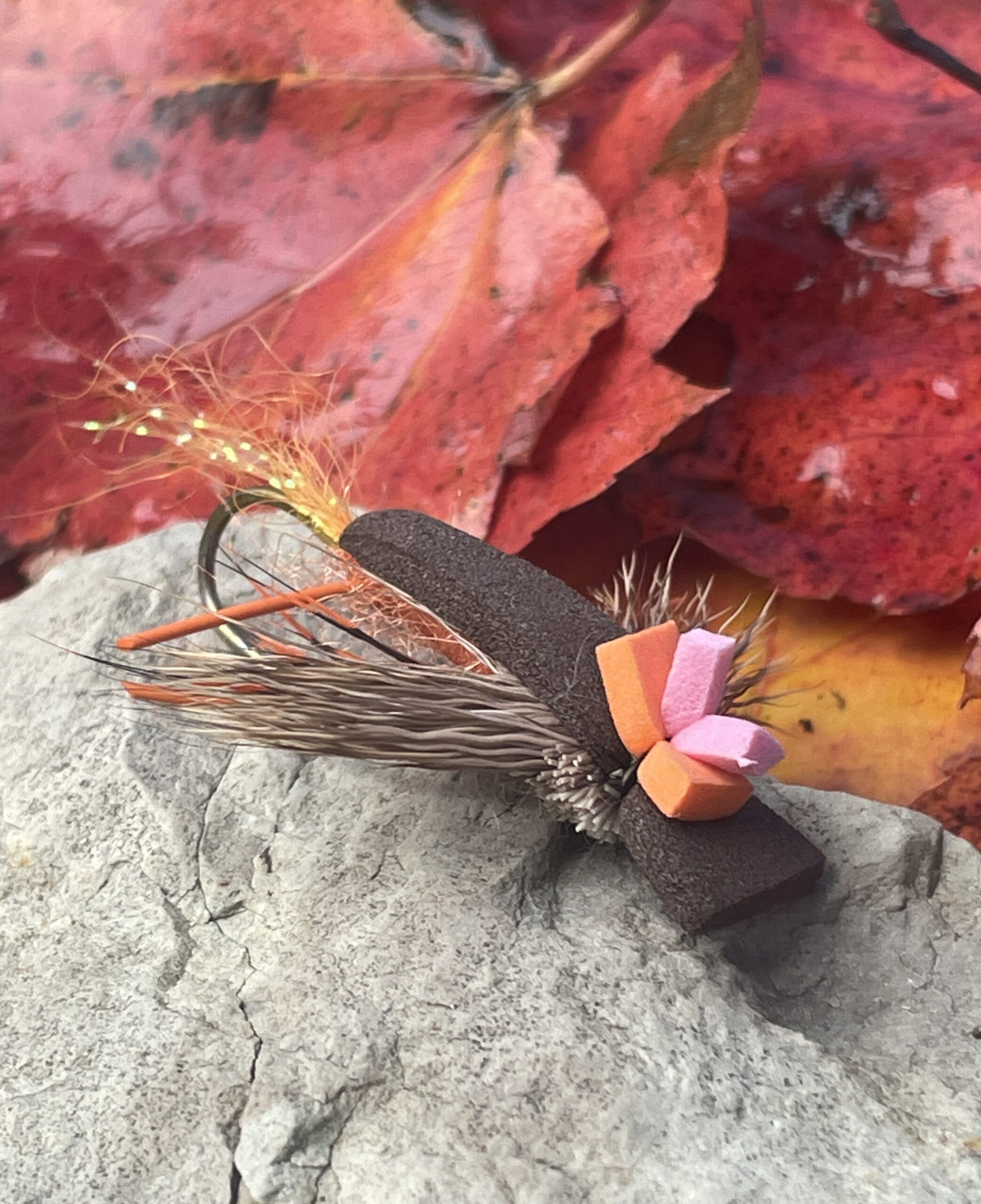
Never Say Never-Break Tradition
Gordie my Gaspe ghillie said, ” You poor guy Matthew, the beat you drew has been fishing poorly with the low and clear drought water, no fish caught in over a month there! ” To me that was the ultimate challenge to get my game on and crack the puzzle. I knew Salmo salar were lovers of novelty. When we got to the pool and the chosen point of where the guide positions the client to swing the wet fly, I did the complete opposite. Gordie freaked out ” You can’t do that!- nobody fishes this pool from there” he shouted. What I did to startle him was since I saw the water was very low and the pool’s current has changed, I jumped to the other side of the river which looked to make more sense, and I started to cast my Red Francis shrimp pattern upstream and across in the old British wet fly style. Stripping the fly back down quickly on the very first cast I had two Atlantics follow the fly to my boots in the water for 10 feet. My ghillie Gordie was shocked! I had a smile on my face as wide as a Cheshire cat. It turned out to be one of the best days of my Atlantic fishing career.
At the end of the day what does all this stuff mean? Feel confident and positive on every trip you go on the hunt for migratory salmonids. Be patient and visualize that every run and pool has fish, even if you can’t see them-fish every piece of water thoroughly. Break out of the dull normal and be creative, and incorporate new methods and flies that are not typical for that river you are fishing- migratory salmonids get bored to tears by our anal mentalities and how we fish. Pay attention to your fly speeds and drifts. If the river you are fishing has been an iconic one over the decades, the fish are there – even if not in the historic numbers they once were. If anything, this new age of lesser will teach us to love and respect each fish that we are lucky and blessed to catch- also treat them with respect by carefully letting them go. Focus on each cast’s presentation and visualize that you are one swing or drift away from redemption, in that the next trophy of your lifetime could strike on the next cast, no natter how many you have done for the day-this is what makes for a true passionate master. Know your prey and their preferences and you will become a fish whisperer- that savvy angler that is everyone envy’s and who sniffs out a fish wherever they go.
As migratory salmonid numbers continue to dwindle, yet angler traffic increases, it will be those “fishy” dudes and gals that prevail and find joy. In the end!- its all about the fish and the beauty of the hallowed waters that they still swim.
Cheers!- Peace!-Love’ em and keep’ em wet!
Matthew Supinski
Note: If you love the content of my featured pieces and blogs, I invite you to come and tune into my Hallowed Waters Podcasts which I host. In-depth candid, creative and brilliant discussions are had on all Trout/ Steelhead /Atlantic salmon subject matters including all dry fly, nymphing, wet fly, Spey, and streamer techniques , with insight into fish behavior with iconic guests, scientists and authors from around the globe, is on each episode. I am also busy working on my ” Trout Bum ” and “Atlantic Salmon & Steelhead ” Chronicles – beautiful hard cover books coming 2024!
Link:
https://podcasts.apple.com/us/podcast/hallowed-waters/id1606667042
